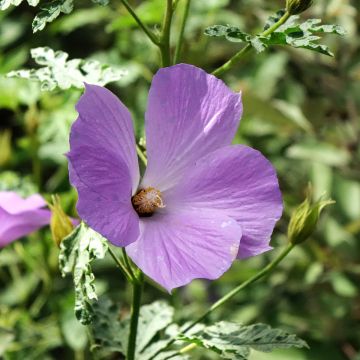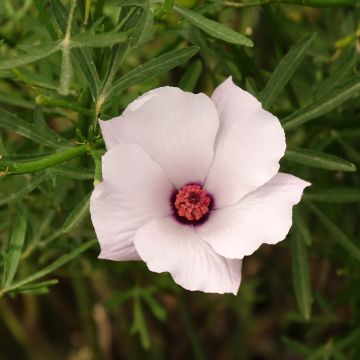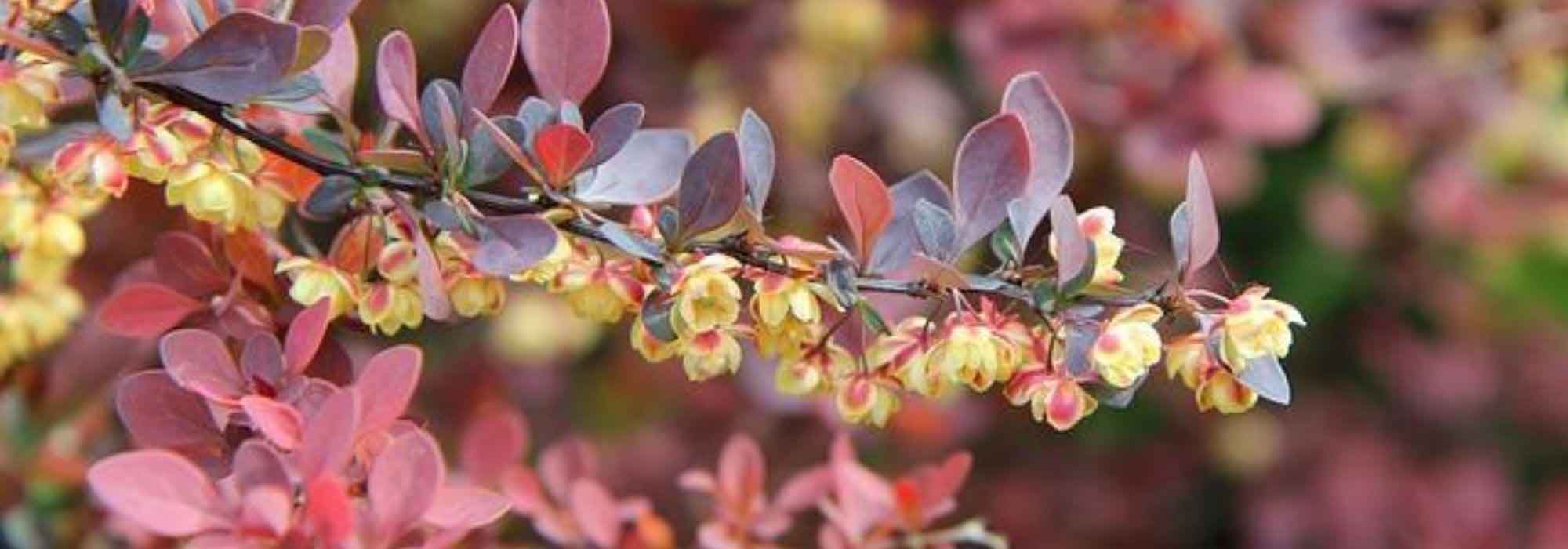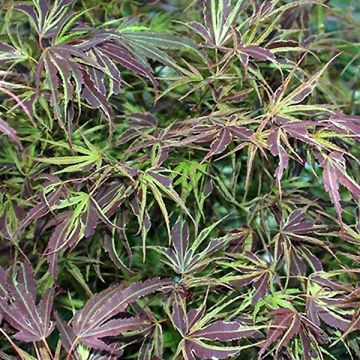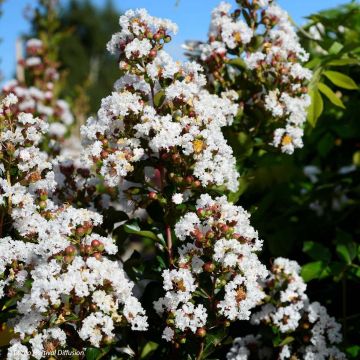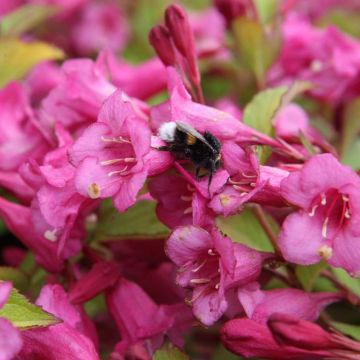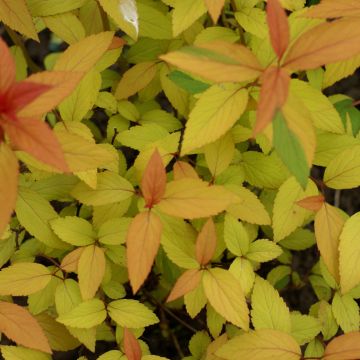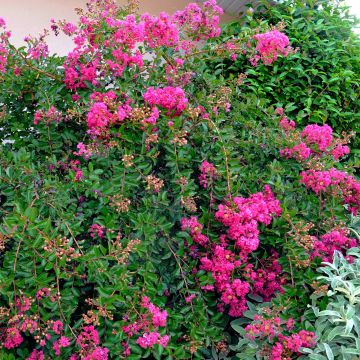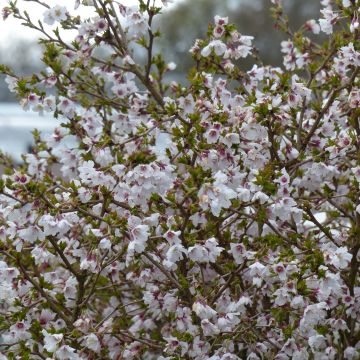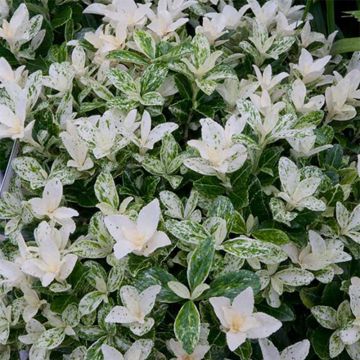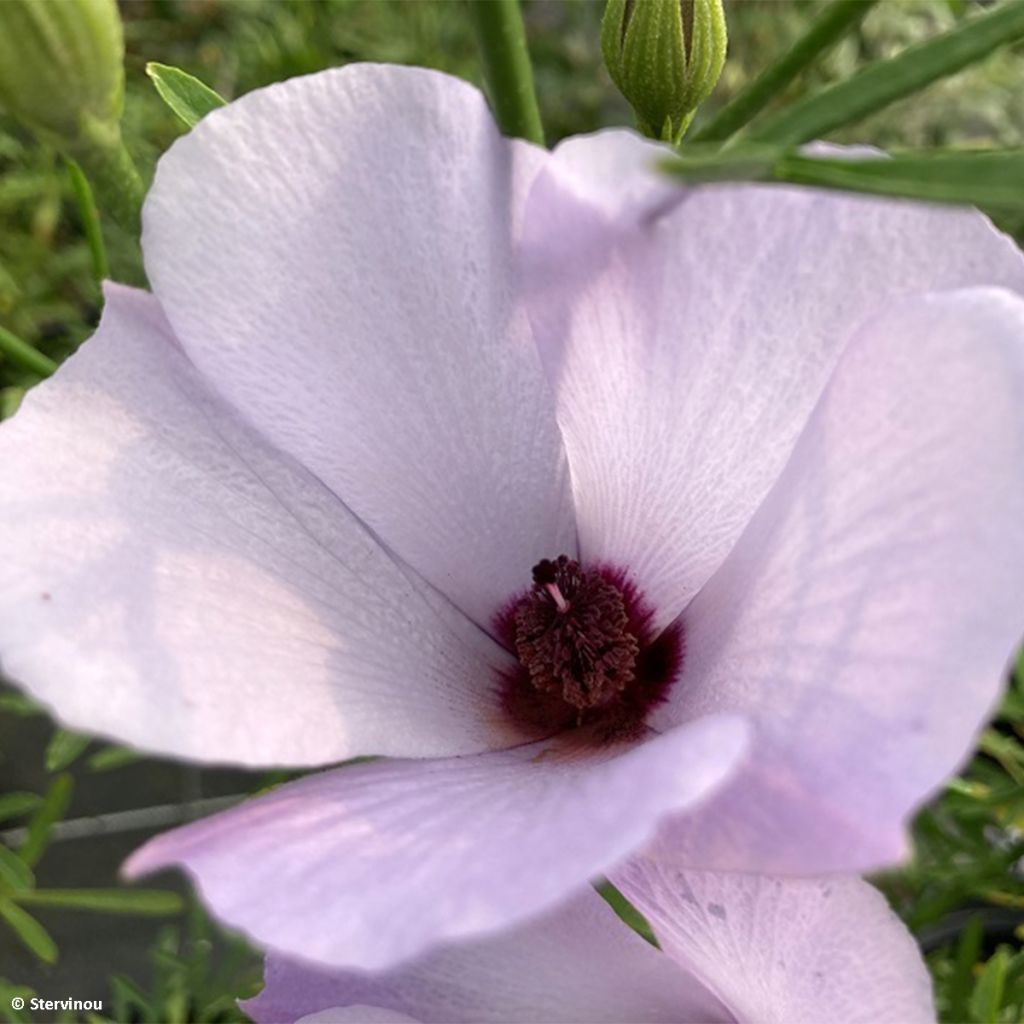

Alyogyne Delightfully - Hibiscus bleu d'Australie, Faux hibiscus
Alyogyne huegelii Delightfully
Alyogyne x huegelii Delightfully
Blue Hibiscus, Lilac Hibiscus
Special offer!
Receive a €20 voucher for any order over €90 (excluding delivery costs, credit notes, and plastic-free options)!
1- Add your favorite plants to your cart.
2- Once you have reached €90, confirm your order (you can even choose the delivery date!).
3- As soon as your order is shipped, you will receive an email containing your voucher code, valid for 3 months (90 days).
Your voucher is unique and can only be used once, for any order with a minimum value of €20, excluding delivery costs.
Can be combined with other current offers, non-divisible and non-refundable.
Why not try an alternative variety in stock?
View all →This plant carries a 12 months recovery warranty
More information
We guarantee the quality of our plants for a full growing cycle, and will replace at our expense any plant that fails to recover under normal climatic and planting conditions.
Does this plant fit my garden?
Set up your Plantfit profile →
Description
Alyogyne Delightfully is a variety of Australian blue Hibiscus with delightful and generous flowering. The flowers of this hybrid are delicately iridescent, a pinkish mauve, adorned with a very dark throat. Diaphanous, they are ephemeral but renew themselves over a very long period on a beautiful bushy shrub dressed in finely cut foliage. Originally from Australia, it is a very pretty plant for sunny coastal gardens, including those with dry soil. Gardeners in more continental climates may cultivate it in a large pot on the terrace or balcony, storing it indoors during winter.
Alyogyne 'Delightfully' is a horticultural hybrid of uncertain origin, likely derived from different Alyogyne species. All of these plants, commonly called Australian blue hibiscus, belong to the Malvaceae family, just like bush mallows and mallow plants. In nature these shrubs are found on the coast, often in sandy soils. Quite adaptable, the blue hibiscus tolerates clay, limestone and granite, but absolutely requires a well-draining soil where water does not stagnate, both in winter and summer. It can withstand brief frosts down to around -5°C (23 °F) if the soil is dry in winter. Flowering is triggered by daytime temperatures equal to or above 20°C and continues as long as the soil is slightly moist. The vegetation is bushy and the persistence of the foliage will depend on the severity of the winter.
With very rapid growth, Alyogyne 'Delightfully' reaches a height of about 1.50m (4 in 11 ft) in just a few months with an almost equivalent width in open ground. In a pot, it will remain somewhat smaller, around 1m (3 in 4 ft) to 1.20m (3 in 11 ft) in all directions. Each flower, about 12cm (4.7 in) wide, is composed of 5 iridescent-textured petals, light mauve in colour, slightly overlapping, arranged in cups. The centre of the corolla, dark purple in colour, is occupied by numerous short stamens with yellow anthers, surrounding 5 longer and partially fused styles, pink-red in colour. Like all plants in the Malvaceae family, the flowers last no more than a day or two, but are produced continuously for nearly 4 months. The abundant foliage consists of leaves 5 to 7cm (2 - 2.8 in) long, thick, divided into 3 to 5 irregular lobes, glossy, and of a bright green colour. To maintain a compact shape we recommend pruning it in March, and also lightly during the growing season. This Alyogyne is a short-lived plant, lasting about 8 years.
Alyogyne should thrive in a coastal garden, without watering, in well-drained, even dry soil in summer and winter. It is essential to protect it from winter humidity. It can be planted in a shrub bed or a large rockery. To accompany it, consider cistus, rosemary, Westringia, tall lavender, bush sage, and Leucophyllum frutescens. These plants, which appreciate the same growing conditions, will create beautiful scenes in combination. It can be cultivated in a large pot, allowing the plant to be sheltered in a bright, unheated room during winter, while significantly reducing watering.
Report an error about the product description
Alyogyne huegelii Delightfully in pictures
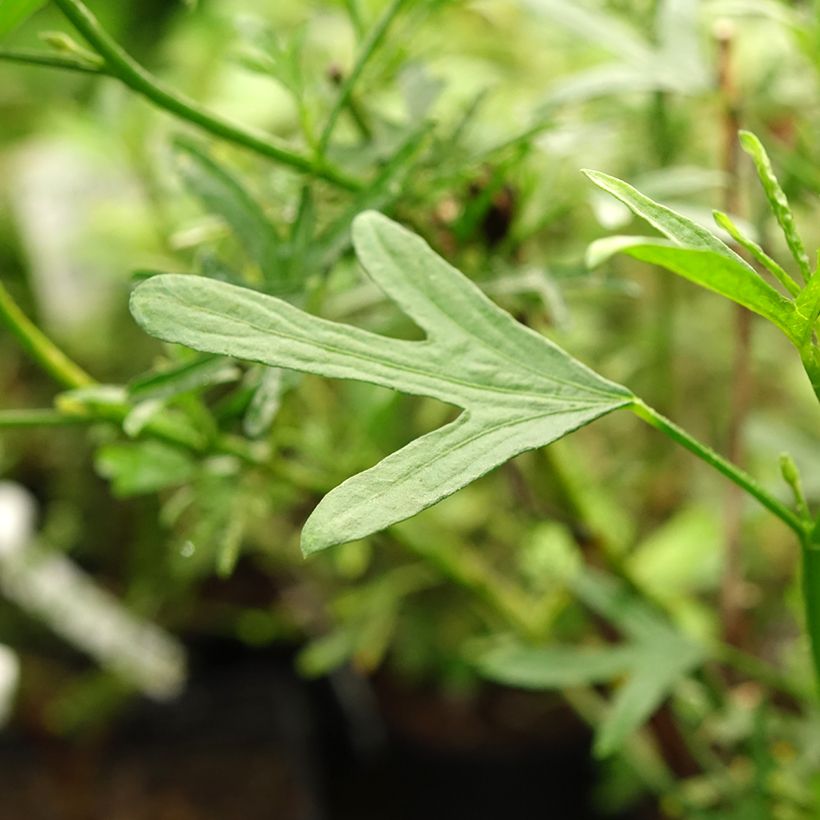

Flowering
Foliage
Plant habit
Botanical data
Alyogyne
x huegelii
Delightfully
Malvaceae
Blue Hibiscus, Lilac Hibiscus
Australia
Other Alyogyne
View all →Planting and care
Alyogyne Delightfully is a plant that thrives in mild winters and hot summers, and withstands summer drought once established. It tolerates sea spray well and thrives in sunny and sheltered coastal gardens. This bush dislikes wet soil in winter, which significantly reduces its hardiness: in a very dry soil during winter, it can withstand short frosts of around -5 °C. In slightly wetter soil, it will perish below -2 °C. It is therefore best planted in spring, in gravel-enriched soil, to give it some time to establish and strengthen before winter. Choose a sunny and sheltered location to ensure flowering and to protect the plant in winter. The soil type is not important, whether slightly acidic, neutral, slightly calcareous, slightly clayey, sandy, or gravelly, as long as it is well-drained. Place a thick mulch around its base as winter approaches, on well-dried soil, to isolate it from moisture, and protect your young blue hibiscus with a winter fleece during the first two winters if frost is forecast. It is capable of regrowing from the base if the vegetation has been destroyed by the cold. Once well-established, the Alyogyne generally does not require watering in summer. However, a generous but spaced-out water supply helps support flowering in summer. Prune back the vegetation if necessary at the beginning and during the growing season to promote good branching of the plant. Fertilising in open ground is not obligatory for this plant, which prefers rather poor and leached soils.
Pot cultivation: choose a pot with a minimum capacity of 20 litres and make sure it has drainage holes at the bottom. Place a layer of gravel or broken pieces of terracotta pots at the bottom of the pot to promote drainage. Prepare a mixture of garden soil and compost, adding some gravel. Regularly water your plant to support flowering, but avoid excessive watering. Like many Australian plants, Alyogyne seems to dislike soils rich in phosphorus: use a fertiliser with a low phosphorus content (N, P, K), preferably mineral rather than organic.
Planting period
Intended location
Care
Planting & care advice
This item has not been reviewed yet - be the first to leave a review about it.
Similar products
Haven't found what you were looking for?
Hardiness is the lowest winter temperature a plant can endure without suffering serious damage or even dying. However, hardiness is affected by location (a sheltered area, such as a patio), protection (winter cover) and soil type (hardiness is improved by well-drained soil).

Photo Sharing Terms & Conditions
In order to encourage gardeners to interact and share their experiences, Promesse de fleurs offers various media enabling content to be uploaded onto its Site - in particular via the ‘Photo sharing’ module.
The User agrees to refrain from:
- Posting any content that is illegal, prejudicial, insulting, racist, inciteful to hatred, revisionist, contrary to public decency, that infringes on privacy or on the privacy rights of third parties, in particular the publicity rights of persons and goods, intellectual property rights, or the right to privacy.
- Submitting content on behalf of a third party;
- Impersonate the identity of a third party and/or publish any personal information about a third party;
In general, the User undertakes to refrain from any unethical behaviour.
All Content (in particular text, comments, files, images, photos, videos, creative works, etc.), which may be subject to property or intellectual property rights, image or other private rights, shall remain the property of the User, subject to the limited rights granted by the terms of the licence granted by Promesse de fleurs as stated below. Users are at liberty to publish or not to publish such Content on the Site, notably via the ‘Photo Sharing’ facility, and accept that this Content shall be made public and freely accessible, notably on the Internet.
Users further acknowledge, undertake to have ,and guarantee that they hold all necessary rights and permissions to publish such material on the Site, in particular with regard to the legislation in force pertaining to any privacy, property, intellectual property, image, or contractual rights, or rights of any other nature. By publishing such Content on the Site, Users acknowledge accepting full liability as publishers of the Content within the meaning of the law, and grant Promesse de fleurs, free of charge, an inclusive, worldwide licence for the said Content for the entire duration of its publication, including all reproduction, representation, up/downloading, displaying, performing, transmission, and storage rights.
Users also grant permission for their name to be linked to the Content and accept that this link may not always be made available.
By engaging in posting material, Users consent to their Content becoming automatically accessible on the Internet, in particular on other sites and/or blogs and/or web pages of the Promesse de fleurs site, including in particular social pages and the Promesse de fleurs catalogue.
Users may secure the removal of entrusted content free of charge by issuing a simple request via our contact form.
The flowering period indicated on our website applies to countries and regions located in USDA zone 8 (France, the United Kingdom, Ireland, the Netherlands, etc.)
It will vary according to where you live:
- In zones 9 to 10 (Italy, Spain, Greece, etc.), flowering will occur about 2 to 4 weeks earlier.
- In zones 6 to 7 (Germany, Poland, Slovenia, and lower mountainous regions), flowering will be delayed by 2 to 3 weeks.
- In zone 5 (Central Europe, Scandinavia), blooming will be delayed by 3 to 5 weeks.
In temperate climates, pruning of spring-flowering shrubs (forsythia, spireas, etc.) should be done just after flowering.
Pruning of summer-flowering shrubs (Indian Lilac, Perovskia, etc.) can be done in winter or spring.
In cold regions as well as with frost-sensitive plants, avoid pruning too early when severe frosts may still occur.
The planting period indicated on our website applies to countries and regions located in USDA zone 8 (France, United Kingdom, Ireland, Netherlands).
It will vary according to where you live:
- In Mediterranean zones (Marseille, Madrid, Milan, etc.), autumn and winter are the best planting periods.
- In continental zones (Strasbourg, Munich, Vienna, etc.), delay planting by 2 to 3 weeks in spring and bring it forward by 2 to 4 weeks in autumn.
- In mountainous regions (the Alps, Pyrenees, Carpathians, etc.), it is best to plant in late spring (May-June) or late summer (August-September).
The harvesting period indicated on our website applies to countries and regions in USDA zone 8 (France, England, Ireland, the Netherlands).
In colder areas (Scandinavia, Poland, Austria...) fruit and vegetable harvests are likely to be delayed by 3-4 weeks.
In warmer areas (Italy, Spain, Greece, etc.), harvesting will probably take place earlier, depending on weather conditions.
The sowing periods indicated on our website apply to countries and regions within USDA Zone 8 (France, UK, Ireland, Netherlands).
In colder areas (Scandinavia, Poland, Austria...), delay any outdoor sowing by 3-4 weeks, or sow under glass.
In warmer climes (Italy, Spain, Greece, etc.), bring outdoor sowing forward by a few weeks.






























